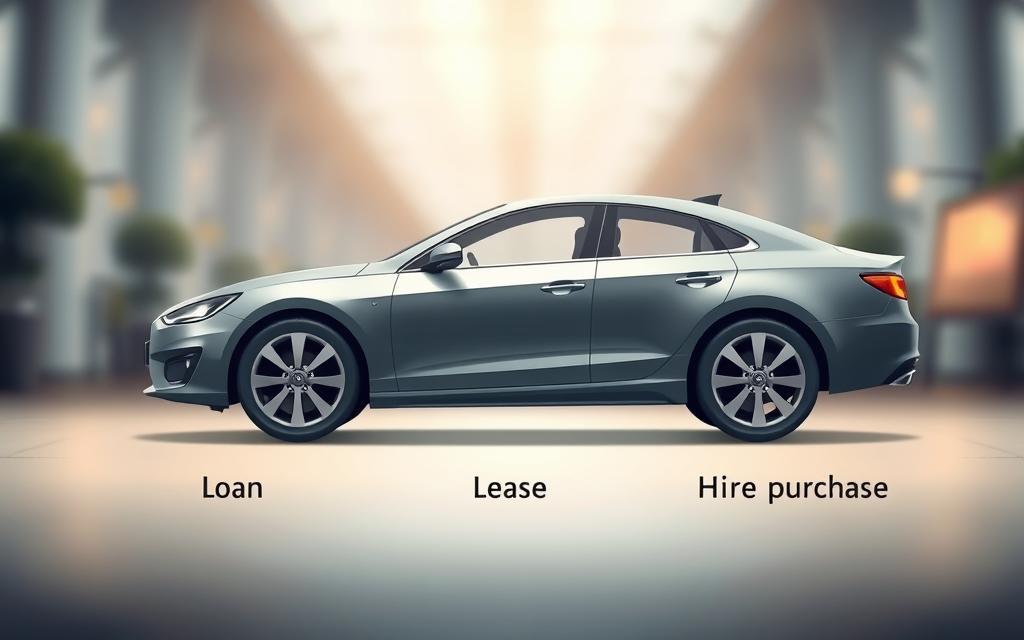adversiment
Over 65% of Australian drivers aren’t sure if buying or leasing a car is best. The car financing market in Australia is complex. It has big effects on personal budgets and long-term money plans.
Choosing between buying and leasing a car in Australia needs careful thought. Aussies now have many ways to get a vehicle. These go beyond just buying outright.
It’s not just about monthly payments. Your choice affects taxes and who looks after the car. Knowing the good and bad points of each can help you decide.
This guide looks at owning and leasing cars in Australia. We’ll explain money matters and practical issues. We’ll also share key tips to help you choose what’s best for you.
Understanding Car Financing Options in Australia
Car financing in Australia can be tricky. It’s vital to know your options when looking at car ownership costs. Your choice can greatly affect your finances and budget.

Australian drivers can buy or lease a vehicle. Each choice has its own money impacts and perks. It’s important to think about these carefully.
Exploring Car Ownership Pathways
Car ownership costs in Australia include several key points:
- Upfront purchase price
- Ongoing maintenance expenses
- Registration and insurance fees
- Potential financing interest rates
Decoding Car Leasing Strategies
Car leasing in Australia offers a different way to get a vehicle. It can be great for those who want more flexible transport options.
| Financing Method | Key Characteristics | Typical Duration |
|---|---|---|
| Purchasing | Full vehicle ownership | Indefinite |
| Leasing | Temporary vehicle usage | 2-4 years |
Buying and leasing cars have different money plans. The right choice depends on individual circumstances, driving habits, and long-term financial goals. Weighing up leasing perks can help you make smart choices.
Pros and Cons of Buying a Car
Car leasing and buying in Australia have different financial impacts. Buying a vehicle is a big investment for Aussie drivers. It requires careful thought and planning.
Car buyers must consider several key factors. These factors affect their financial and practical choices. They shape the overall ownership experience.
Advantages of Vehicle Ownership
- Complete ownership with no restrictions on mileage
- Freedom to modify and customize the vehicle
- Potential to build equity over time
- No recurring monthly lease payments
Disadvantages of Car Ownership
Buying a car in Australia has some major drawbacks. These can impact your finances and lifestyle choices.
- Substantial upfront costs
- Rapid vehicle depreciation
- Ongoing maintenance expenses
- Potential repair costs after warranty expiration
| Ownership Aspect | Financial Impact |
|---|---|
| Initial Purchase | High upfront investment |
| Depreciation Rate | 20-30% value loss in first year |
| Annual Maintenance | $500-$1500 depending on vehicle |
Knowing these factors helps Aussies choose between leasing and buying cars. It ensures they pick the best option for their budget and needs.
Pros and Cons of Leasing a Car
Car leasing in Australia offers flexible and affordable solutions. It’s a smart alternative to owning a car. Short-term car usage has gained popularity among Aussie drivers.
Leasing a vehicle has unique benefits and challenges. Understanding these can help you make an informed choice.
Benefits of Leasing a Vehicle
- Lower monthly payments compared to car purchases
- Access to newer vehicle models every few years
- Reduced maintenance costs during lease period
- Potential tax advantages for business users
- Simplified vehicle upgrade process
Drawbacks of Leasing a Car
- Strict mileage restrictions
- No ownership at lease conclusion
- Potential significant end-of-lease fees
- Limited customization options
- Continuous monthly payments
Leasing is great for short-term car use in Australia. It offers flexible arrangements to suit different budgets.
| Lease Aspect | Advantage | Consideration |
|---|---|---|
| Monthly Cost | Lower payments | No equity buildup |
| Vehicle Condition | Always drive newer model | Strict wear and tear standards |
| Maintenance | Reduced repair costs | Limited repair flexibility |
Leasing is a nuanced option. It requires careful thought about your driving needs and finances.
Financial Implications of Buying vs Leasing
Car financing in Australia requires careful analysis. Understanding cost structures for buying and leasing helps make informed decisions. Affordable car solutions vary based on individual needs.
Purchasing a vehicle involves several upfront financial considerations. The initial investment goes beyond the sticker price. It includes multiple expense categories.
Upfront Costs of Purchasing a Vehicle
- Down payment typically ranges from 10-20% of the vehicle’s value
- Registration fees vary by state and vehicle type
- Stamp duty charges based on vehicle purchase price
- Insurance premiums for comprehensive coverage
Leasing Expenses Breakdown
Leasing offers a different financial approach for Australian drivers. It provides flexible car financing options. The cost structure differs significantly from purchasing.
| Lease Cost Component | Typical Expense |
|---|---|
| Security Deposit | 1-2 months of lease payments |
| First Month’s Payment | Paid upfront |
| Acquisition Fee | $500-$1000 |
| Documentation Fees | $300-$600 |
Drivers must weigh short-term affordability against long-term financial benefits. Each option has unique implications. These depend on individual circumstances and driving needs.
Australian car financing options offer diverse paths for consumers. Assessing personal finances helps choose between buying and leasing. The best choice depends on your specific situation.
Maintenance and Repairs: Buying vs Leasing
Vehicle maintenance is a key factor in car ownership costs in Australia. Understanding maintenance responsibilities and expenses helps drivers choose between buying and leasing. This knowledge aids in making informed decisions about vehicle options.
Maintenance duties vary greatly between owned and leased vehicles. Your approach to upkeep can affect your car leasing benefits in Australia. It also impacts your long-term financial planning.
Vehicle Maintenance Responsibilities
Car owners are fully responsible for all maintenance and repair costs. This includes regular service intervals, unexpected mechanical repairs, and parts replacement. Routine inspections are also the owner’s responsibility.
Warranty Considerations
Warranties are crucial in managing maintenance expenses. Leased vehicles usually come with manufacturer warranties. These warranties cover most major repairs during the lease term.
| Maintenance Aspect | Purchased Vehicle | Leased Vehicle |
|---|---|---|
| Routine Service | Owner’s Expense | Often Included |
| Major Repairs | Full Owner Responsibility | Mostly Warranty Covered |
| Annual Maintenance Cost | $800-$1500 | $300-$600 |
Tip: Always review warranty terms carefully when considering vehicle purchase or lease options in Australia.
Flexibility and Commitment: Leasing vs Buying
Car ownership in Australia involves weighing short-term flexibility against long-term commitment. Your personal car lifestyle choices play a crucial role in this decision.
Australian drivers face unique challenges in balancing mobility with financial practicality. The choice between leasing and buying affects your financial freedom and lifestyle adaptability.
Lease Terms and Flexibility
Leasing offers several advantages for those seeking flexibility:
- Short-term commitments typically ranging from 2-4 years
- Option to change vehicles more frequently
- Lower upfront costs compared to purchasing
- Reduced maintenance responsibilities
Leasing provides an attractive option for individuals who prefer driving newer models without long-term financial constraints.
Ownership and Long-term Commitment
Purchasing a vehicle presents a different set of opportunities:
- Complete vehicle ownership after loan repayment
- Freedom to modify or sell the car at will
- Potential for building equity
- No mileage restrictions
Your car lifestyle choices will determine whether leasing or buying suits you best. Consider your driving habits, budget, and future plans carefully.
This decision impacts your personal and financial goals. Take time to assess your needs before making a choice.
Depreciation and Equity in Car Ownership
Car ownership in Australia involves two key concepts: depreciation and equity. These factors affect your vehicle’s long-term value and car financing options Australia.
Depreciation is the drop in a car’s value over time. In Australia, most cars lose 15-20% of their value yearly. New cars can lose up to 60% of their value in three years.
Impact of Vehicle Depreciation
Several factors affect a car’s depreciation rate:
- Vehicle make and model
- Mileage
- Maintenance condition
- Market demand
Building Equity Through Ownership
Car ownership lets you build financial equity. Your loan payments increase your stake in the vehicle. Unlike leasing, where monthly payments don’t contribute to ownership, buying lets you own the car outright.
To minimize depreciation and maximize equity, maintain your car well. Choose models with strong resale value and keep mileage moderate. These steps can boost your car’s long-term value in Australia.
Insurance and Running Costs
Car ownership costs in Australia involve complex insurance and ongoing expenses. Understanding these financial aspects is vital for making smart decisions about vehicle ownership.
Your budget can be greatly affected by insurance expenses. Each vehicle ownership model has its own insurance considerations.
Insurance Expenses for Purchased Vehicles
Owning a car usually requires comprehensive insurance to protect your investment. Several factors influence your insurance premiums.
- Vehicle make and model
- Driver’s age and driving history
- Location and parking arrangements
- Annual kilometres driven
Insurance Costs for Leased Cars
Leased vehicles often need specific insurance arrangements. Lease agreements typically require higher coverage levels to protect the lessor’s asset.
| Insurance Type | Purchased Vehicle | Leased Vehicle |
|---|---|---|
| Comprehensive Coverage | Optional but recommended | Usually mandatory |
| Average Annual Premium | $800 – $1,500 | $1,000 – $2,000 |
| Additional Requirements | Personal choice | Lessor-specific conditions |
Knowing these insurance details helps Australian drivers make financially savvy decisions about their vehicle ownership strategy.
Making the Right Choice for Your Lifestyle
Choosing between buying and leasing a car in Australia depends on your personal situation. Your car lifestyle choices affect which option suits you best. Understanding your needs is key to making a smart decision.
Think about your annual mileage and how often you use a vehicle. Buy vs lease strategies vary based on individual driving patterns. City folks might prefer leasing, while regional drivers could benefit from owning.
Evaluating Personal Driving Needs
Your financial situation is crucial when selecting a vehicle. Consider your income, future changes, and long-term money goals. Some Aussies like predictable lease payments, while others value building equity through ownership.
Look at your budget, possible tax effects, and overall financial plan. These factors will help you make the best choice for your situation.
Financial Planning Insights
The right choice balances your lifestyle needs with money constraints. Consider talking to a financial advisor who knows the Australian car market. They can offer personalised advice for your specific circumstances.
An expert can help you navigate the complexities of getting a car. With their guidance, you’ll feel more confident in your decision.



